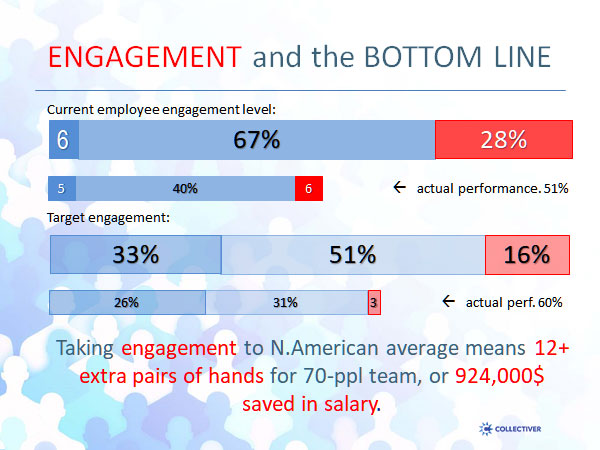Unlocking Employee Engagement: Driving Productivity and Profits #2
Summary: As a business leader, you hold the key to unlocking the full potential of your workforce. However, achieving high levels of employee engagement is no easy feat. If you are like most American businesses today, two out of your three employees or teammates are not engaged. And that, according to Gallup, is the highest engagement level worldwide: the global average employee engagement is only 21 percent.
Could we have reached the natural limit of engagement?
In this post, we will delve into the strategies and insights specifically tailored to business owners and leaders. Discover how you can drive employee engagement, enhance productivity, and maximize profits within your organization.
This is the original Part-1 of a 3-Part series merged into this one article.
Defining Employee Engagement
Employee engagement is more than a buzzword; it’s a catalyst for success. It is the emotional commitment the employee has to the organization and its goals (Forbes) and the involvement and enthusiasm of employees in their work and workplace (Gallup).
Employee engagement is the emotional commitment the employee has to the organization and its Purpose. Employee engagement is the involvement and enthusiasm of employees in their work. It is driven by the emotional connection an employee has with the company.
The True Costs of (dis)Engagement
While some may dismiss employee engagement as an insignificant expense, the truth is far from it. In fact, disengagement can have a significant financial impact on your organization’s bottom line.
Recent studies by McLean & Company reveal that a disengaged employee can cost your organization $3,400 for every $10,000 in annual salary.
These costs manifest as reduced productivity, increased absenteeism, high staff turnover, lost business opportunities, and safety incidents. Ignoring employee engagement is a costly mistake that business leaders cannot afford.
Leveraging Productivity for Profits
Let’s look at the financial implications of productivity levels within your workforce. These costs of (dis)engagement are hidden even from business leaders.
Your organization can be divided into three categories: engaged, not engaged, and disengaged employees. Engaged employees align with your company’s purpose and values, working at their peak potential (80-100%). Disengaged employees openly exhibit dissatisfaction and contribute only 20% of their productivity potential. The remaining not engaged employees operate at approximately 60% of their capacity.
The engaged work at 80-100 % of their capacity. (Nobody can realistically work more than 100%).
According to research, employees must maintain productivity at about 40 percent to keep their job. The disengaged are below that, about 20 percent on average.
The remaining – not engaged – employees work at about 55 percent of their potential.
We may safely approximate that an average enterprise has about 20% engaged employees, 60% not engaged, and 20% disengaged (a 20:60:20 ratio). That corresponds to 18%+33%+4%=55% effective productivity only!
By improving the 20:60:20 ratio, you have the power to unlock significant efficiency within your organization. This means optimizing employee engagement to drive productivity and increase your profits.
Unlocking the Potential within Your Organization
As a business leader, you understand the unique challenges you face in driving employee engagement. Small and mid-sized businesses (SMBs) often encounter lower levels of employee engagement than the national average. This presents an extraordinary opportunity for improvement.
Let’s take a look at a real-life example:

Current productivity (baseline):
Engaged: 6%@90% = 5%, Not Engaged: 67%@60% = 40% DisEng 28%@20% = 6%
Effective productivity today = 51%
Target productivity (if we achieve the US/Can average):
Engaged: 33%@80% = 26%, Not Engaged: 51%@60% = 31%, DisEngaged: 16%@20% = 3%
Realistic productivity in 6-12 months = 60%
In this scenario, by improving employee engagement, your SMB could unlock over $900K of additional salary funds within a year. But that’s only the beginning. These improvements are not temporary; they will have a lasting impact on your organization’s success. By focusing on employee engagement, you can allocate resources towards growth and expansion instead of costly recruitment and replacement efforts. (More about it in Part 4 – The Performance Triangle: Three Factors that Boost Team Potential.)
Let’s look at the calculation from the opposite end: by not doing anything to improve their employee engagement, this typical SMB leaves about $1M on the table every year.
Employee Engagement: Practical Steps to Take Now
This is Part 2 of the original “How to improve employee engagement”. In this part, we introduce the first practical steps you should take to improve your team’s engagement.
While searching for a good definition of employee engagement, I came across a short and clear one that I had never heard of before.. This definition is very informal, but it accurately points you in the right direction:
Employee engagement is the opposite of burnout.
If you’ve ever experienced it or been close enough to a state of chronic emotional and physical exhaustion, you may remember the symptoms: low energy, inability to concentrate, fear of failure, frustration, and bitterness. In most cases, these symptoms are caused by unattainable goals, unclear criteria for success and vague responsibilities, lack of ability to make decisions and control one’s activities, and the absence of a meaningful Purpose.
Another hint that should help you internalize the problem: What type of organization has never had employee burnout?
You may know the answer, it has been known for decades. Peter Drucker gave it decades ago: volunteer organizations. Independently, Frederic Herzberg came up with another fundamental conclusion that should help you finalize the picture. He said: “Do not look for an answer to “How do I get them to do what I want?” Focus on “How to make them want to do what I want?” Indeed, the real key to motivating employees is to activate their internal drivers.
To make your team want what you want (assuming that you want what the company needs; however, that’s the responsibility of your manager), you need to eliminate the potential causes of burnout. This is the foundation on which you can grow a healthy and efficient organization that will encourage, promote and support high employee engagement.To make your team want what you want (assuming that you want what the company needs; however, that’s the responsibility of your manager), you need to eliminate the potential causes of burnout. This is the foundation on which you can grow a healthy and efficient organization that will encourage, promote and support high employee engagement.
1: Make sure your people have clear roles and responsibilities, and tangible, measurable, achievable goals.
Often, especially with the “agile” or “lean” fads, everyone is doing everything, and everyone is responsible for everything. That sounds exciting and democratic but is equivalent to no-one is responsible and nobody is completing anything. That could work for an early startup. However, if you are beyond that stage, this will never work and if left unattended, will drive the business into the ground.
You need to establish a system of communications, lateral and vertical, a Meaningful Meeting Matrix, so that the necessary information is shared and the progress is reported on clear KPIs.
Note: Meaningful Meetings, by themselves, are your first addition to the baseline. A client SMB used to have a three-hour-long weekly Senior Team meeting. Within the first three weeks of the improvement initiative, they slimmed it down to one hour weekly. More important: they were able to achieve this efficiency because now they could come to a meaningful result and agreement by the end of the hour, while previously they would finish their three-hour meeting frustrated and only because they all “had other commitments.”
(What’s the cost of 14 hours of top-management time saved per week? Share your guess in the comments.)
2: Move the decision-making as close as possible to the frontline workforce (in other words, eliminate micromanagement) and keep communication channels open.
If your team members have realistic and measurable goals, they will figure out how to achieve them. Just keep your door open and be ready to offer support if and when it is required. Plus, let them map and eventually optimize their processes. This will not happen overnight, but the exercise makes them talk, and agree on responsibilities, dependencies and handover points. Just that one agreement creates massive improvements.
3. With your team involved throughout the process, discover, analyze and document your company’s values and Purpose.
Yes, “discover”: you cannot impose your aspired values on your team; you have to find them out through meetings and one-on-one communications. This step should have been the #1 item. Realistically, your business is ongoing, and it will only make things worse if you tell your team what are their values. If you expect to take your team to the next level, you need to start a parallel discussion with them.
“But this touchy-feely stuff is not in our culture!” says my adamant client, an SMB owner and an “experienced leader.”
And rightly so: in most cases, embarking on a journey of increasing employee engagement is a culture change. Typically, it consists of creating, improving, and measuring throughout the process. We started from the “improving” step because in most cases you have a team in place already.
How to Measure Employee Engagement
This is Part-3 of the original “How to improve employee engagement. Here you will learn why measuring employee engagement is important and how to set up a process for your team at no cost to the company. You can go back to Part 1 for key definitions and Part 2 for the first practical steps you should take to improve your team’s engagement.
Whether you are building a team from scratch or planning to improve the engagement of the existing team, you need to start measuring and monitoring employee engagement as soon as possible.
Here my opponents would eagerly note that Peter Drucker(!) said “If you can’t measure it, you can’t manage it” – and they will be terribly wrong. First, Peter Drucker never said that. Rather it was W. Edwards Deming, a statistician by birth, who said something close – but different:
“It is wrong to suppose that if you can’t measure it, you can’t manage it – a costly myth.”
Deming’s point was: In management, there are things that you can’t measure using only the available data, but quite often you have to use your judgment and common sense.
Looking at the employee engagement matters from the 21st century, I would add that when you manage people – i.e. “soft stuff“ – using “hard data” may become counterproductive. On the other hand, if you are friends with common sense, you may use creative measurements – and come up with useful benchmarks and guides.
For example, healthcare professionals often use a Pain Scale when talking to patients: “On a scale of 1 to 10, how strong is your pain?” This is a very subjective “self-reported” measurement but it allows to monitor the healing process. Likewise, there is an opposite measurement – the Subjective Happiness Scale (SHS). The latter is less known only because humans are genetically focused on risk avoidance (the “survival instinct”) but not on opportunity enhancement.
The important part is not how precisely you measure – but how you set up the employee engagement initiative and how well you communicate with your people. And right away you may benefit from measuring and monitoring two sets of data:
Your team’s performance potential
The success or failure of your engagement improvement initiative depends on the top management. If you are the top management, you need to start from your team (of VPs or Directors, your direct reports) and run a benchmark assessment. If you are not CEO but want to improve your team’s engagement, the approach is the same, but you may need more cojones to make a change.
Again, there are many tools you can use and you only need one – provided you can use it again in the future.
I like Patrick Lencioni’s team assessment tool from “The Five Dysfunctions of a Team.” Lencioni made the list of his questions available in his books, brochures and on his website. You can download the questionnaire and have the entire assessment done “by hand” in minutes. For a “two-pizza” team of 5-10 people, this low-tech approach will take you less time than ordering the assessment online or through a “certified partner.” If you are a large organization, with hundreds of people to assess and a lot of cash to spend, you may as well do that. However, by definition, this team assessment score is of great value to a small, tight-knit team, but its value is questionable if you are measuring average behaviors of a crowd.
In my practice, I have created a simple online tool that allows my clients to run a similar one-minute “self-test” during any meeting, whenever they decide to take another benchmark and check their progress, for free.
Meaningful Meetings Monitor
The quality of company meetings at all levels has a big impact on employee engagement. Meetings for managers are like operations for surgeons: meetings is where management happens. Hence, another parameter that you must start monitoring right away is your meetings’ quality.
The key here is continuous and consistent monitoring. My MMM tool is possibly the most effective tool that I have ever used in practice, and certainly the most efficient one: it’s ROI is close to infinity, guaranteed. In essence, MMM is a ten-point checklist. The hardest part is to have enough discipline to check the ten points right after every meeting, and document the results. Optionally, you can do it in Excel, visualize the progress, note areas for improvement, and email the printout to the team.
You can read everything about the MMM tool, and download the checklist here.
Employee Engagement Survey
Now that we have the management people aligned and monitored, let’s get to the employee engagement measurement. Like with every other parameter on the way to culture change, it is necessary to benchmark your team’s current state, regardless of the engagement level.
Although many companies may recommend “better alternatives,” the Q12 Employee Engagement Survey by Gallup remains the leader here. It is another good example of an effective self-reported measurement tool. It consists of twelve (+ one) questions that your employees answer confidentially, using a 1 to 5 scale. This is very subjective, but this baseline is enough to see progress compared to the results of the same survey 6-12 months later.
It is possible to find a sample Q12 report generated by Gallup and extract the complete questionnaire from there. There are many articles on the web explaining its results; google, and ye shall find. You may then go the low-tech way. Simply, use a paper questionnaire and collect and analyze the data manually as I suggested with “The Five Dysfunctions” assessment above. However, you may need a professional to do that properly, especially if your organization is large. Plus, unlike Patrick Lencioni, Gallup hide the math and transparently allude to their exclusive copyright to the questions.
However, many alternative versions of the questionnaire are offered by other professionals on the Internet, and “proprietary formulas” are not very difficult to develop. They will be different from Gallop’s, but it doesn’t matter as long as you use the same questions for the follow-up assessment.
Still, if you have enough money, Gallup’s fully automated online assessment may be an effective solution. Except for one annoying detail. In a way, Gallup charges a premium for comparing your organization’s data with that of “other players in your niche.” This is an extra cost with no added value: Why would you pay to know the average body temperature of other, unknown patients in the same hospital? You only need to know your temperature today and your temperature tomorrow.
For that reason, you might opt for an “unbranded” but free test that, if you have some aptitude, you can conduct yourself. When the time comes to assess the results of your employee engagement improvement effort, you will simply run it again and compare the results.
Full disclosure: Yes, this is what I recommend and what I would do.
If all the tools described in this Part 3 sound intimidating, but you realize that something must be done to boost your company’s productivity and culture, take a good look at what your employees have posted on Glassdoor. In case your company employs more than twenty people and is older than a few months, you absolutely must find some reviews and ratings on Glassdoor, and if there are none – that’s not a good sign…
Regardless, ask your people to leave their comments on Glassdoor. In case they have privacy concerns, tell them that Glassdoor staff will never disclose the identity of raters to anybody. And if and when they change their opinion of the company, they can go back and edit their rating – thus providing “real-time” inputs to the management.
Note that Glassdoor ratings reflect primarily employee job satisfaction, not their engagement (which can be assessed indirectly). Although strongly correlated, motivation and engagement are not the same thing, and it is important to understand the difference and act on it.
This confusion of employee engagement with motivation and job satisfaction is another reason why employee engagement remains low after all these years.
About the Author
Sergei Brovkin is the founder of Collectiver Incorporated, a consultancy that helps businesses and aspiring business leaders to reach their potential and achieve immediate and lasting performance improvement.
He earned his MScEng in Control Systems and Automatics at the Saint Petersburg State Marine Technical University and his MBA in Strategic Management at McGill University.






